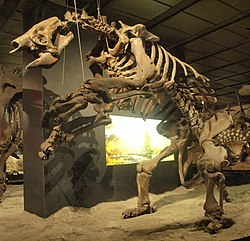エレモテリウム
| エレモテリウム属 | |||||||||||||||||||||||||||
|---|---|---|---|---|---|---|---|---|---|---|---|---|---|---|---|---|---|---|---|---|---|---|---|---|---|---|---|
 ヒューストン自然科学博物館の骨格標本
| |||||||||||||||||||||||||||
| 分類 | |||||||||||||||||||||||||||
| |||||||||||||||||||||||||||
| 学名 | |||||||||||||||||||||||||||
| Eremotherium Spillmann, 1948 | |||||||||||||||||||||||||||
| 種 | |||||||||||||||||||||||||||
 化石の分布図
|
エレモテリウム (Eremotherium) は、新生代第四紀更新世の北アメリカ大陸と南アメリカ大陸に生息していたオオナマケモノの一種である。
形態[編集]


エレモテリウムは南アメリカ大陸に分布していたメガテリウムに匹敵する大きさを持つ最大級のオオナマケモノであり、体長は6メートル、四足歩行時は体高2メートル、直立時は高さ4メートルに達したとされており[1]、体重も3-6.55トンになったと考えられている[2][3][4]。
エレモテリウムとメガテリウムは他のオオナマケモノ類と比較しても明らかに大型であり、更新世以降の南北アメリカ大陸に生息していた最大級の陸棲哺乳類の一角であった。この2種は体長や体重から見ても長鼻目に匹敵する大型動物であった[5][6]。一方で、頭蓋骨は長さや幅などではメガテリウムに匹敵したものの、全体的にはより軽量な構造をしていた[7]。
オオナマケモノであるために現生の樹上性のナマケモノとは大きく姿が異なり、プロポーション的により短いが強力な手足を持ち、かぎ爪も力強く、尻尾も現生種より長かった[8]。
なお、メガテリウムなどにも言えるがエレモテリウムが現生のナマケモノと同様の毛を体表に持っていたのか、それとも現生のゾウのようにほとんど毛を生やしていなかったのかは明らかになっていない。
分布[編集]

メガテリウムとは対照的にアメリカ大陸間大交差を経て北米大陸にまで生息を広めたことが最大の特徴であり、オオナマケモノ全体で見ても最も分布が広大だったとされている。北米大陸の南部に到達した後も、間氷期の比較的に温暖な時代にはより北方に進出したとされている[9][10]。
化石の年代分布は鮮新世後期から後期更新世末期であり、北はニュージャージー州・サウスカロライナ州・ジョージア州から南はリオグランデ・ド・スル州に拡散していたが、絶滅した後期更新世末期の頃には現在のアメリカ合衆国には見られずにメキシコが北限であった[9][10][11][12]。
なお、標高2,000メートルを超える高地からも化石が発見されている[12]。
なお、南アメリカ大陸においては本種とメガテリウムは隣接する形で分布しており、あまり重複が見られないのも特徴的である。
絶滅[編集]

エレモテリウムの厳密な絶滅の時期は判明していないが、もっとも新しい時代の化石は11,340BPに該当しており、アマゾン川の支川であるタパジョース川の付近から発見されている[13]。
本種やメガテリウムなどのオオナマケモノ類は、他の多くの陸棲大型動物と同様に後期更新世から完新世初期に大量に絶滅しており、厳密な絶滅の要因がすべて解明されているわけではないが、人類による影響が大きな要因だった可能性が挙げられている[14]。
一方で、パレオ・インディアンが加工した可能性があるエレモテリウムの歯が発見されているものの[14]、これらの歯の変形は自然のプロセスを経て発生したものであると否定する意見も存在しており[15]、本種が人類の狩猟対象になっていたことを示す確実な証拠はまだ発見されていない[14]。
脚注[編集]
出典[編集]
- ^ Cartelle, Cástor (2000). “Preguiças terrícolas, essas desconhecidas” (Portuguese). Ciência Hoje (Instituto Ciência Hoje).
- ^ Mário, Dantas (2017) Isotopic paleoecology of the Pleistocene megamammals from the Brazilian Intertropical Region: Feeding ecology (δ13C), niche breadth and overlap p.152
- ^ Franz Spillmann: Contributions to the knowledge of a new gravigrade giant steppe animal (Eremotherium carolinense gen. et sp. nov.), its habitat and its way of life. Palaeobiologica 8, 1948, pp. 231-279
- ^ Paul, Gregory S. (1998). “Terramegathermy And Cope's Rule In The Land Of Titans”. The Upper Jurassic Morrison Formation: An Interdisciplinary Study. Gordon and Breach Science Publishers. pp. 179–217. ISBN 90-5699-183-3
- ^ Richard M. Fariña, Sergio F. Vizcaíno and Gerardo de Iuliis: Megafauna. Giant beasts of Pleistocene South America. Indiana University Press, 2013, pp. 1-436 (pp. 216-218) ISBN 978-0-253-00230-3
- ^ Sergio F. Vizcaíno, M. Susasna Bargo and Richard A. Fariña: Form, function, and paleobiology in xenarthrans. In: Sergio F. Vizcaíno and WJ Loughry (eds.): The Biology of the Xenarthra. University Press of Florida, 2008, pp. 86-99
- ^ Cástor Cartelle and Gerardo De Iuliis: Eremotherium laurillardi: The Panamerican Late Pleistocene megatheriid sloth. Journal of Vertebrate Paleontology 15(4), 1995, pp. 830–841 ( online )
- ^ M Susana Bargo, Sergio F Vizcaíno, Fernando M Archuby and R Ernesto Blanco: Limb bone proportions, strength and digging in some Lujanian (Late Pleistocene-Early Holocene) mylodontid ground sloths (Mammalia, Xenarthra). Journal of Vertebrate Paleontology 20(3), 2000, pp. 601-610
- ^ a b McDonald, H. Gregory (June 2023). “A Tale of Two Continents (and a Few Islands): Ecology and Distribution of Late Pleistocene Sloths” (英語). Land 12 (6): 1192. doi:10.3390/land12061192. ISSN 2073-445X.
- ^ a b França, Lucas de Melo; Araújo-Júnior, Hermínio Ismael de; Dantas, Mário André Trindade (1 August 2023). “Taphonomy, paleoecology and chronology of a late Quaternary tank (natural reservoir) deposit from the Brazilian Intertropical Region” (英語). Quaternary Science Reviews 313: 108199. doi:10.1016/j.quascirev.2023.108199 2024年4月28日閲覧。.
- ^ Virginia L Naples and Robert K McAfee: Reconstruction of the cranial musculature and masticatory function of the Pleistocene panamerican ground sloth Eremotherium laurillardi (Mammalia, Xenarthra, Megatheriidae). Historical Biology: An International Journal of Paleobiology 24 (2), 2012, pp. 187-206
- ^ a b Carbot-Chanona, Gerardo; Gómez-Pérez, Luis Enrique; Coutiño-José, Marco Antonio (2022-07-30). “A new specimen of Eremotherium laurillardi (Xenarthra, Megatheriidae) from the Late Pleistocene of Chiapas, and comments about the distribution of the species in Mexico”. Boletín de la Sociedad Geológica Mexicana 74 (2): A070322. doi:10.18268/BSGM2022v74n2a070322.
- ^ Rossetti, Dilce de Fátima; Toledo, Peter Mann de; Moraes-Santos, Heloı́sa Maria; Santos, Antônio Emı́dio de Araújo (2004). “Reconstructing habitats in central Amazonia using megafauna, sedimentology, radiocarbon, and isotope analyses”. Quaternary Research 61 (3): 289–300. Bibcode: 2004QuRes..61..289D. doi:10.1016/j.yqres.2004.02.010.
- ^ a b c Dantas, Mário André Trindade; de Queiroz, Albérico Nogueira; Vieira dos Santos, Fabiana; Cozzuol, Mario Alberto (March 2012). “An anthropogenic modification in an Eremotherium tooth from northeastern Brazil”. Quaternary International 253: 107–109. Bibcode: 2012QuInt.253..107D. doi:10.1016/j.quaint.2011.09.019.
- ^ Hubbe, Alex; Haddad-Martim, Paulo M.; Hubbe, Mark; Neves, Walter A. (August 2012). “Comments on: 'An anthropogenic modification in an Eremotherium tooth from northeastern Brazil'”. Quaternary International 269: 94–96. Bibcode: 2012QuInt.269...94H. doi:10.1016/j.quaint.2012.01.029.
